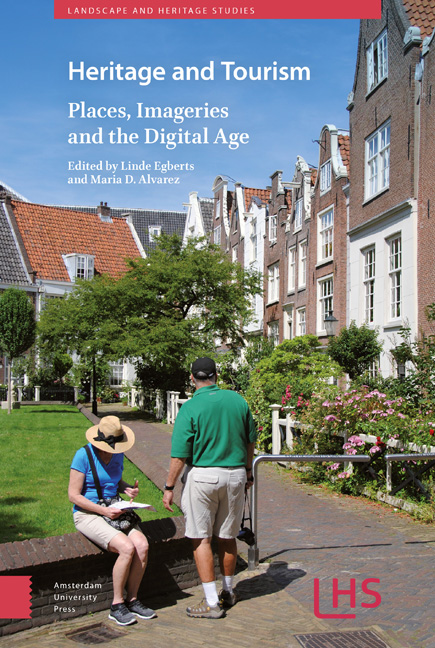Book contents
- Frontmatter
- Dedication
- Contents
- List of Figures and Tables
- Foreword
- 1 Tourism and Heritage: Crafting Experiences Through Innovation
- 2 Tourism Conflicts and Conflict Tourism: Curating “Holoscapes” in Europe’s Age of Crisis
- 3 Heritage Landscapes of Hiroshima and Nagasaki
- 4 Revealing and Presenting the Past(s) for the Public: Fethiye Mosque and Museum as a Cultural Heritage Site in Istanbul
- 5 Who Takes the Lead in Initiating Cooperation in a Cultural Network and Why?: The case study of a Rural Finnish Destination
- 6 Sustainability of Heritage-Tourism Destinations: A Demand-Based Perspective on Cusco, Peru
- 7 Localising National Tourism Websites: The case of World Heritage sites
- 8 Enhancing the Tourist Heritage Experience through “In-Situ”, Customisable, 3D-Printed Souvenirs
- 9 Tracking the Heritage Tourist: Heritage tourism and Visiting Patterns in a Historic City
- 10 The Construction of a Tourist-Historic Icon: The case of the Palace of Westminster, London
- 11 Conclusion
- Index
8 - Enhancing the Tourist Heritage Experience through “In-Situ”, Customisable, 3D-Printed Souvenirs
Published online by Cambridge University Press: 22 December 2020
- Frontmatter
- Dedication
- Contents
- List of Figures and Tables
- Foreword
- 1 Tourism and Heritage: Crafting Experiences Through Innovation
- 2 Tourism Conflicts and Conflict Tourism: Curating “Holoscapes” in Europe’s Age of Crisis
- 3 Heritage Landscapes of Hiroshima and Nagasaki
- 4 Revealing and Presenting the Past(s) for the Public: Fethiye Mosque and Museum as a Cultural Heritage Site in Istanbul
- 5 Who Takes the Lead in Initiating Cooperation in a Cultural Network and Why?: The case study of a Rural Finnish Destination
- 6 Sustainability of Heritage-Tourism Destinations: A Demand-Based Perspective on Cusco, Peru
- 7 Localising National Tourism Websites: The case of World Heritage sites
- 8 Enhancing the Tourist Heritage Experience through “In-Situ”, Customisable, 3D-Printed Souvenirs
- 9 Tracking the Heritage Tourist: Heritage tourism and Visiting Patterns in a Historic City
- 10 The Construction of a Tourist-Historic Icon: The case of the Palace of Westminster, London
- 11 Conclusion
- Index
Summary
Abstract
This research set out to investigate whether technological innovations in design and the personalisation of tourist souvenirs through 3D printing could offer opportunities to break away from stereotypically throwaway, low-quality, mass-manufactured products that souvenir consumption is often associated with. The study was undertaken within a historic environment in Stirling, Scotland, producing 3D-printed souvenirs insitu and inviting visitors to comment on the finished item. The chapter discusses the perceptions of the visitors of the souvenirs in terms of quality and value and concludes by reflecting on the implications of the findings for heritage attractions in terms of sustainability, authenticity, intellectual property rights, engagement with technology, and areas for future research.
Keywords: souvenir personalisation, authenticity, 3d printing, visitor Attraction
In most contemporary museums and galleries “gift shops” offer as “souvenirs” products that reflect and represent their collections or artefacts (Swanson & Timothy, 2012). The purchase of souvenirs can transform an intangible experience into a tangible, lasting memory of the visitor's engagement with these spaces and objects (Collins-Kreiner & Zins, 2011). However, the mass-market production of these souvenirs may, in fact, detach the visitor from the actual heritage experience due to their unsustainable, globalised manufacture, disposability, and confused styling (Errington, 1998). Gift shops have at times been described as “inauthentic” and “homogenised” (Boorstin, 1961), “commodified products”, “imitations”, “deceptions” (Greenwood, 1997), “staged” (MacCannell, 1973), “socially constructed interpretation of the genuineness of observable things”, or “mass standardisations oriented towards the export market” (MacCannell, 1989).
Technological innovation has altered the consumption of tourism products and experiences (Andersson, 2007; Gretzel, Fesenmaier, Formica, & O’Leary, 2006) allowing for the creation of tourist experiences that are memorable and compelling (Neuhofer, Buhalis, & Ladkin, 2012; Pine & Gilmore, 1999), sensuous (Crouch & Desforges, 2003) and creative (Richards & Wilson, 2006). Aided by these developments a creative group has emerged among tourists of “empowered consumers [who] actively participate in (re) constructing their everyday experiences at home and in the world” (Gretzel & Jamal, 2009) and who seek individualised experiences of the spaces they visit in order to increase their knowledge and promote self-development. In this way co-creative experiences are produced that are unique to each visitor and more meaningful than externally staged and scripted tourist experiences.
- Type
- Chapter
- Information
- Heritage and TourismPlaces, Imageries and the Digital Age, pp. 151 - 170Publisher: Amsterdam University PressPrint publication year: 2018



